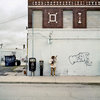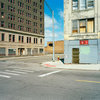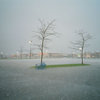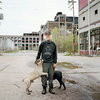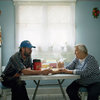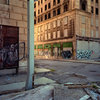A Conversation with Dawin Meckel
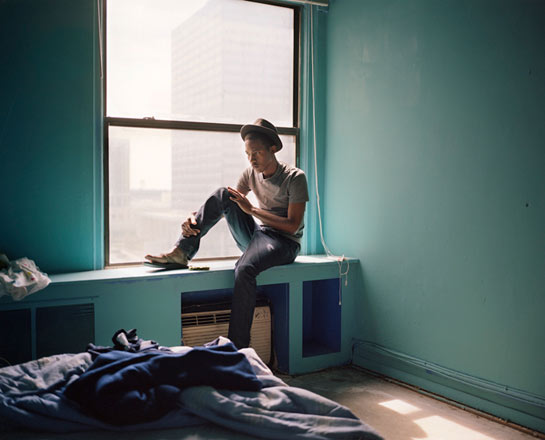
Shortly after discovering Dawin Meckel’s portrait of Detroit, I approached him to find out more about this body of work: How did he go about photographing Detroit? How did this body of work get made? (more)
Jörg Colberg: Going to Detroit to take photographs seems like such a curious decision, given there is so much work coming out of Detroit, and given Detroit has become such a symbol for lazy narratives about America (see all the debates about “ruin porn” etc.). Why did you decide to take photographs in Detroit of all places?
Dawin Meckel: Almost three years ago, I decided to do a project on Detroit for our OSTKREUZ group exhibition The City. Becoming and Decaying. Some colleagues were trying to prevent me from doing so. They were worried that as there were so many projects dealing with Detroit as a shrinking city, there was the risk of becoming stuck in a cliché. As a matter of fact most of the works on Detroit I came across during my research didn’t go further than showing the aesthetics of run-down buildings. There were no people in those pictures. I decided to portray the inhabitants that had remained in this post-industrialized city and find out what impact the decay of their environment had on their lives. I soon realized that the story was not only about life in Detroit but also about loneliness. You can, of course, feel lonely in any city but in the case of Detroit this potential is enhanced by the abandoned environment.
JC: What was it that made you realize that?
DM: One of the first things which struck me about Detroit was the emptiness of many parts of the city.
As a matter of fact since the 1950s the population has decreased from nearly 2 million to 900.000 people. Last month I came across scenes from a documentary film shot in the city center of Detroit during the post-war area. I couldn’t believe how crowded the city once was and how confident its inhabitants appeared.
In Detroit loneliness is not only perceptible but also visible. Today houses, places and streets built to host masses of people are desolated. Some former neighborhoods are fallow land now, buildings are burned down in order to keep drug dealers out. And those people still living in Detroit are scattered all about this enormous urban area. Of course, being surrounded by people does not shield you from loneliness either, sometimes the opposite is true, and still living in a city designed for and once inhabited by many more makes you necessary feel somehow left over.
JC: How did you approach taking photos in Detroit? How did you prepare for it?
DM: I only had one contact I had made via the internet, a blogger who writes about the local hip hop scene and introduced me to a lot of his friends. I mostly relied on coincidences though.
JC: Did you have a general idea of what you wanted to portray before you went?
DM: Before I left, I had the idea of telling the story of Detroit by portraying the hip hop scene, as many of the artists deal with the environment in their songs. Soon after my arrival I realized that focusing on them would have made the perspective too narrow, I would have lost out on many other stories to tell and places to show. I felt that for me the combination of environmental portraits and photos of architecture was the right way of approaching the city.
JC: Your photographs contain a large amount of portraits. How did you go about finding subjects to take photos of?
DM: During my three-weeks stay I spent a lot of time driving around in my rental car searching for people and places to portray. Luckily, I soon met Zigmund. He lived in one of the most desolated areas I came across. He is a carpenter in his sixties, staying with his mum and two
brothers and actually among the last white people living there. Zigmund would always carry around two things: a hammer and a red mug filled with one liter of beer. He approached me saying that it was a bad idea for a stranger with a camera to walk around on his own in areas like that, as everyone would take me for an undercover cop in search of drug dealers. He offered to show me around in his neighborhood and gave me his phone number. It was actually the best
thing that could happen to me and still, strangely and sadly enough, you are always suspicious if somebody you haven’t met before offers to help you without expecting any profit. We met very often and had a very good time together. Coincidences like that always happen when you are open towards strangers.
JC: More generally, when taking photographs in a place one doesn’t know and where one will only stay for a limited amount of time is always tricky: How can one avoid aiming for clichés? How does one get to know the place well enough to take good photographs?
DM: I think you always get to know a place best when getting to know the people who live there. Whereas some encounters only lasted five minutes (for example, when I met the elderly man who was dressed up nicely and on his way to a jazz concert), I could never have taken some other pictures without getting to know the person better, and during various meetings I more and more got an idea of how I wanted to portray them. Very soon after meeting Zigmund for the first time I had the idea of taking a picture of him and his mother in their kitchen, in a very private
and secluded atmosphere. He never took me to his mum though, she probably did not want a German photographer in her house. So after two weeks he came up with the idea of introducing me to a good friend, a lady he calls his stepmother. The longer they sat talking at the kitchen table, the more they forgot about me and held hands while confiding really sad episodes of their lives to each other. This really was the picture I had been searching for, a picture showing that people stick together even if their environment (which you can guess outside the window) is threatening. I could perhaps stage the setting but never the situation nor the atmosphere.
JC: Does being there, in such moments, also cause you not to take a photo, because it would feel wrong or inappropriate to take one? How do you handle the tricky line between documenting and intruding?
DM: It’s true, I really feel like an intruder in situations like this and I would never take a picture if anybody minds. Sometimes a gesture or a glimpse are all it takes to understand if it is appropriate to take pictures or not. It’s all about trust and respect.
 By
By 